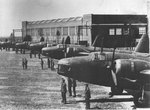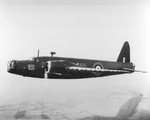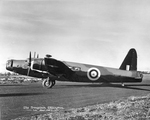Wellington
| Country | United Kingdom |
| Manufacturer | Vickers-Armstrongs, Limited |
| Primary Role | Medium Bomber |
| Maiden Flight | 15 June 1936 |
Contributor: C. Peter Chen
ww2dbaseThe Wellington twin-engine medium bombers were designed by R. K. Pierson in the mid-1930s. The design proved to be tough even when damaged in battle, but it was complex enough that it hampered production somewhat. The first Royal Air Force bombing involving Wellington bombers took place on 4 Sep 1939, where Wellington bombers from No. 9 and No. 149 Squadrons, along with Blenheim bombers, attacked German shipping at BrunsbĂÂŒttel, Schleswig-Holstein, Germany. On 25 Aug 1940, they participated on the first night raid on Berlin. On 30-31 May 1942, Wellington bombers made up 599 of the 1,046 aircraft sent to attack Cologne; in that raid, 2,000 tons of high explosives were delivered in a 90-minute window, destroying 250 factories as well as downtown Cologne, killing countless civilians and leaving 45,000 homeless. As they were replaced by more modern designs, Wellington bombers were transferred to the Middle East and Asia. During the design's production life, 11,464 were built.
ww2dbaseSource: Wikipedia.
Last Major Revision: Jul 2007
Wellington Timeline
| 16 Oct 1941 | RAF Pilot Officer A. J. Heyworth was able to return hom to Britain after his Wellington bomber suffered serious damage while bombing Mannheim, Germany. He flew most of the way on only one engine while the other was aflame. |
| 4 Jun 1942 | Shortly after midnight the Italian submarine Luigi Torelli bound for a patrol area off Puerto Rico was attacked by Squadron Leader Jeaff Greswell's (No. 172 Squadron RAF) Leigh Light equipped Wellington bomber. The attack (the first to be made using a Leigh light) caused extensive damage to the Italian submarine, which was forced to abort her mission and return to port for repairs. |
| 6 Jul 1942 | The British RAF Coastal Command scored its first enemy vessel sunk with the newly equipped Wellington bombers. |
| 13 Oct 1945 | The last of 11,461 Vickers Wellington aircraft to be built rolled off the production line. |
SPECIFICATIONS
Mk IC
| Machinery | Two Bristol Pegasus Mk. XVIII radial engines rated at 1,050hp each |
| Armament | 2x7.7mm nose turret Browning machine guns, 4x7.7mm tail turret Browning machine guns, 2x7.7mm waist Browning machine guns, 2,000kg of bombs |
| Crew | 6 |
| Span | 26.27 m |
| Length | 19.69 m |
| Height | 5.33 m |
| Wing Area | 78.40 m² |
| Weight, Empty | 8,417 kg |
| Weight, Maximum | 12,927 kg |
| Speed, Maximum | 378 km/h |
| Rate of Climb | 5.70 m/s |
| Service Ceiling | 5,486 m |
| Range, Normal | 2,905 km |
Photographs
 |  |  |  |
Did you enjoy this article or find this article helpful? If so, please consider supporting us on Patreon. Even $1 per month will go a long way! Thank you. Share this article with your friends: Stay updated with WW2DB: |
Visitor Submitted Comments
4 Aug 2009 03:50:43 AM
A squadron of the South African Airforce (26 Squadron SAAF) was equipped with Wimpys and based in Takoradi, Gold Coast(Now Ghana)during WWII. They carried out anti submarine patrols and convoy escourt duty over the Atlantic. See 26 Sqn website at http://mysite.mweb.co.za/residents/bd000006/
26 Jan 2012 11:24:00 AM
My grandfather flew a wellington bomber in ww2 in the middle east his squadron was 38 his name was FLT SGT Henry Lilley . Sadly he did not return his right engine was gone and most of the crew bailed out . But he was still flying it his name is at AL Alamein need to get there one day RIP grandad
2 Mar 2014 11:17:06 PM
My father Richard David Swan built Lancs during the war. I am trying to find out more info - which factory etc
13 Apr 2014 01:11:25 AM
Mr. Chen,
Thanks for the wonderful site.
The 11,000-odd figure for Wellington production seems on the high side, I seem to recall that 3-4000 were built.
Thank you again.
Don
13 Apr 2014 01:13:20 AM
Mr. Chen,
Please accept my apologies, a brief search revealed your production figure to be correct- I had forgotten that they were built right through the end of the war.
Best regards,
Don
3 Feb 2015 12:42:41 PM
My father William Thomas Packwood served in the RAF 1939- 1945. Ground crew Wellington bombers he was stationed in North Africa and also Germany. Born in Dudley. Would anyone have any idea which squadron this would be. And a shot in the dark if any body reads this about him if any past family members heard of him.
Regards Peter,
16 Dec 2015 01:01:57 PM
I note no mention of Barnes Wallis in the development of the Wellington, I always was led to believe he was responsible for the geodesic design of the fuselage, true or propaganda?
16 Dec 2015 05:12:43 PM
Rex Pierson was Vickersâ chief designer for the Wellington but that design relied heavily on geodesic construction principles developed by Barnes Wallis in his pre-war work on airship design. The bomber Wallis is best known for having a greater role in developing was the Lancaster.
30 Jan 2016 10:29:14 AM
My grandfather, Joseph W. Bonen, flew with the Civilian Technical Corps in the UK in WW2. My mother remembered that he flew Wellington bomber and was with RAF or RCAF. I have been unable to find any further information online re this. Any suggestions?
Thanks
13 Apr 2016 03:39:53 AM
My father flew Wellingtons in the Nth Africa and Italy campaigns based at Blida Algeria in 150 Squadron RAF and was there during 1942-43 .The desert air force played a decisive role aiding the eventual collapse of Nazi German and Italian occupation of the middle east
16 Aug 2016 09:53:20 AM
What happened to the two Wellington Bombers that at were at R.A.F.Cosford when I left there in the middle 50's. They were in a moth balled state but one of them was "airworthy"as it was unoffically stripped and flown by a flight Sargent pilot.He was apparently court marshalled.
19 Dec 2017 04:28:28 PM
460 SQN RAAF in WWII flew Vickers Wellington Bombers. BUT I fail to see the Wellington listed in the Royal Australian Air Force (RAAF) Series of Air Craft that served with in the RAAF. This to me means the Wellington Bomber wasn't a RAAF Asset. Who did they belong to??
27 Dec 2017 03:39:10 AM
Hi
Any 1 knows about Wellington with mor ethan 6 crewmembers ?
thank u
Yehuda
27 Dec 2017 03:56:34 AM
Hi
any 1 knows somthing about 8 Aircrew kIA at 25.08.1944 buried in Haifa cematery ?
names:
1-c.g.r adams. pailot
2- r.h breach
3- j.jhohanstone
4 -d.e macdonald
5 - g.marr
6 -t. robinson
7 -f.s mulder
8- s.c williams
Thanks
31 Mar 2018 12:41:06 PM
My great Uncle Sgt. Wallace Carter died 03/04/1943 as a gunner flying over France, 166 squadron. I have an excellent photo of him in his âBigglesâ helmet
27 Nov 2018 11:32:27 AM
Yehuda Wegman Wellington Bombers normally carried a crew of 5 or 6 but some French manned Wellingtons had a crew of 7. One such aircraft crashed at Bunker Hill near Consett, Co Durham, England
12 Nov 2019 10:22:18 AM
My father and two of his six brothers flew in Bomber Command for the RAF. They were Canadians who, rather than wait for the fledgling RCAF to get organized, volunteered for secondment to the RAF. My father, who was the only brother to survive the war, was a Wellington pilot with RAF 40 Squadron who spent his time in England bucking the embedded arrogance embedded of many high ranking RAF functionaries who played the card that 'colonials' were a lower species of warrior and pilots. One argument to that effect in which he defended Canadians got him and his mixed crew suddenly sent to Africa via his Wellington in daylight on a flight path close in to the French Coast along the Bay of Biscay on their way to Gibraltar, re-fuelling, and on to Tunisia's Kairouan East airfield. Two Me-109s shot them up and only the intervention of clouds and his decision to break with the flight plan they were supposed to follow got them to Gib.
After many 38 ops from Kairouan East they eventually followed the Allied invasion of Italy to settle at the massive airbase in Foggia, Italy his crew later volunteered to join a small group that only had to complete three, low-level, single plane night raids on strategic targets chosen by RAF high command. The deal was if they completed three they all received leave -- 4 weeks for the UK boys and 6 for the colonials to allow they to get home for a decent time.
They carried a single 4000lb. 'cookie' and were to drop it at the highest speed they could attain in a shallow dive after a short close-to-target climb to 800-1000 feet, then a diving to 250-300 feet above the target and dropping the cookie at speed. These strategic targets were picked by RAF high command.
My father recorded that of the eight crews from the squadrons that volunteered, two made it to three missions. My father was one but they survived the third only after being shot down by a series of Nazi river shore batteries and a Flak Train protecting a vulnerable link in the main rail connection from the Ploesti oilfields to Nazi Germany - a twin tracked rail bridge.
Upon crash landing in Rumania, the surviving crew spent ninety two harrowing days dodging German patrols while being hidden by Serbs loyal to the Crown who were led by the devout anti-Nazi Serbian, General Mikhailovich.
They were finally resewed, along with nearly 150 or so American aircrew, by the breathtakingly bold OSS 'Operation Lanyard' of which a movie documentary was supposedly made. My father and his navigator were the only Canadians rescued. They never forgot the courage and kindness of the Royalist Serbs who hid them, fought for them and died for them every day. They also had life-long friendships with many American crews they fought and hid with who signed a piece of my fathers parachute which I have now.
My father never expected a medal despite everything but he did resent that he and his Canadian navigator never received the 'mentioned in dispatch' that the two surviving British crew members did. Was my father anti-British? No. He met some decent high-ranking RAF officers in the Mediterranean Theatre or he could have been, but the ones in the UK did their very best to make him so!
29 Dec 2019 12:51:18 PM
My grandfather was in a crew that flew SOE flights, unfortunately his journals were taken by a researcher about 20 years past when he was ill so tracking his exploits is difficult!
14 Feb 2020 06:56:39 PM
My father served with the RAF in wellingtons in North Africa from Jan 1942 to 1944, initial training was at 72 OTU (circa December 1941), he serves as a rear gunner,. In March 1944 he was promoted to Flight Sergeant, he was later sent out to Southern Rhodesia's RAF training division at Cranbourne airforce base and then after returning to England late 1945 joined in bomb disposal until August of 1946, If anyone has any knowledge or info on my father, Roy Whittaker I would appreciate it, no matter how small or insignificant it may seem, all is welcome...
20 Jun 2020 12:37:19 AM
To my knowledge there are just two surviving Wellingtons. One, a Mark X, serial MH628, is on display at the RAF Museum at Cosford, and has been carefully preserved although, apparently, it didnât see any operational service during World War Two. The other is the famous âLoch Nessâ Wellington, a Mark IA serial N2980, which was discovered by a team of American researchers hunting for skeletons of prehistoric aquatic animals. This machine flew many missions with 149 Squadron during 1939-1940 (including participating in the fateful attack on Wilhelmshaven which saw all but nine bombers shot down by enemy fighters). It was lost, through engine failure, on 31 December 1940 while on a navigation exercise with 20 OTC having made a forced landing in the frozen Loch where it was discovered 44 years later. The Loch Ness Wellington has been partially rebuilt and is currently on display at the Brooklands museum in Surrey.
12 Oct 2021 12:48:40 PM
My uncle was lost, presumed killed, in 1940 or 1941 after his Wellington came down somewhere over North Africa. His name was Philip Owen Davis and he is remembered at a memorial site in Egypt. I have not been able to find out much about what happened, but have been told by relatives that a number of Wellington bombers were lost that day/night, and there was little information provided at the time about what actually happened. I have been unable to find out anything more but some in the family talk about the bombers crashing for no apparent reason and the facts being covered up. My father, who was about 6 at the time, remembers taking the telegram of this sad news to his mother and seeing her break down when reading it. I grew up knowing of this story and always wanted to know what happened. My grandfather and Philip's brothers never really spoke about it, and only now, my father, the last remaining brother of the four, has asked me to see if I can find out what actually happened. Philip was just 18 when he died and a navigator in his aircraft. He went to Downside School and is remembered there with a photograph on a wall commemorating all those lost in wars. I would be very grateful if anyone has information about what happened or someone could point me in the right direction to help me find out what happened. Thank you.
12 Oct 2021 01:03:46 PM
I have just written about my uncle - Philip Davis, who was killed in North Africa in a Wellington. Having checked a few known facts, I realise I got a few details wrong! He died on November 1, 1942 and his grave is at Alamein. He was 20 when he died (not 18), and his full name was Philip John Davis, but I believe the rest of the details I supplied were correct. Any information about what happened still welcome!! Thank you.
27 Nov 2021 06:46:20 AM
Hello William,
I was interested to read your message. According to the CWGC site, your uncle was a sergeant RAFVR service no.1314813.
His body was not found and he is commemorated on the Alamein Memorial at col.261.
However, the site doesn't mention his squadron. Do you know which it was? Was it 70 Sqn by any chance?
Good luck with your research,
ATB, Kenneth
25 May 2022 06:23:56 PM
My father in law, Omer R. Paul, joined the RCAF, but served on detachment in Africa, on the Wellington, with the RAF. Unfortunately, in his later life, when he could finally talk about his experience, his medals and records had been lost in a fire, he had already been diagnosed with Alzheimer's, so I was unable to follow up on his life in the North African Desert.
I know that he was an air gunner on the Wellington on the day his aircraft was shot down. All the crew perished, and it was a miracle that he survived. He had severe burns, and spent many months recovering in Egypt, and then in South Africa, before being sent back to Montreal by sea as a POW guard.
Is there any way to determine the specific Wellington crews that had been shot down where there was a single survivor. That would be him, and would allow me to put at least part of his history together.
Bob ( a veteran attempting to complete the family record)
18 Dec 2022 03:42:33 AM
Looking to trace the flying history of a Vickers Wellington TOJ N3019. My father was had been a rear gunner on this Wimpy. I have a picture of it in flight, and would be happy to upload.
All visitor submitted comments are opinions of those making the submissions and do not reflect views of WW2DB.
» Wallis, Barnes
- » 1,150 biographies
- » 337 events
- » 43,917 timeline entries
- » 1,241 ships
- » 350 aircraft models
- » 207 vehicle models
- » 375 weapon models
- » 123 historical documents
- » 260 facilities
- » 470 book reviews
- » 28,549 photos
- » 432 maps
Lt. Gen. Lewis B. "Chesty" Puller, at Guadalcanal
Please consider supporting us on Patreon. Even $1 a month will go a long way. Thank you!
Or, please support us by purchasing some WW2DB merchandise at TeeSpring, Thank you!
1 Sep 2007 10:34:29 AM
Affectionally named Wimpy-The Wellingtons nickname originated from the character J.Wellington Wimpy of the Popeye cartoons